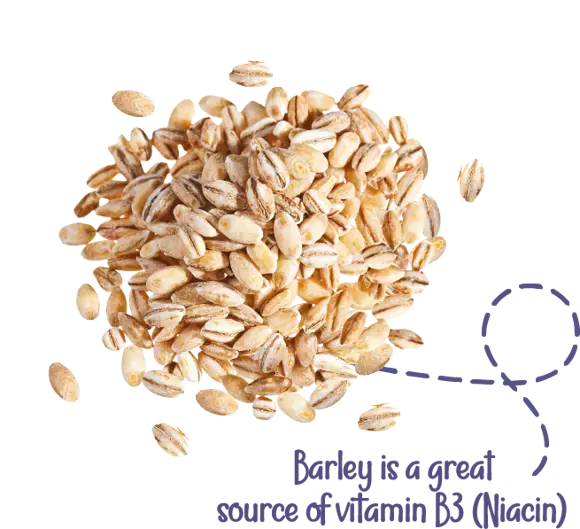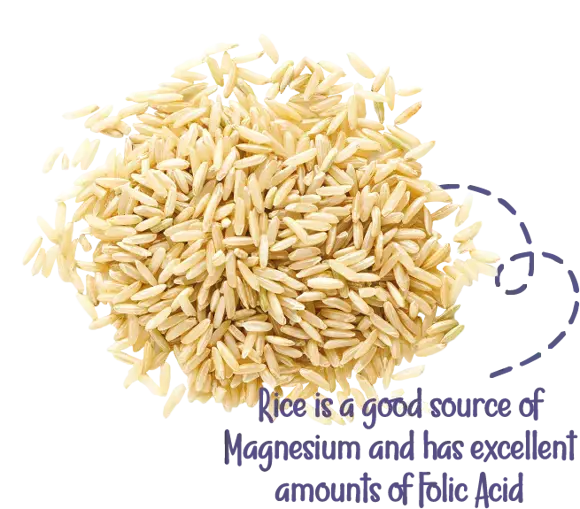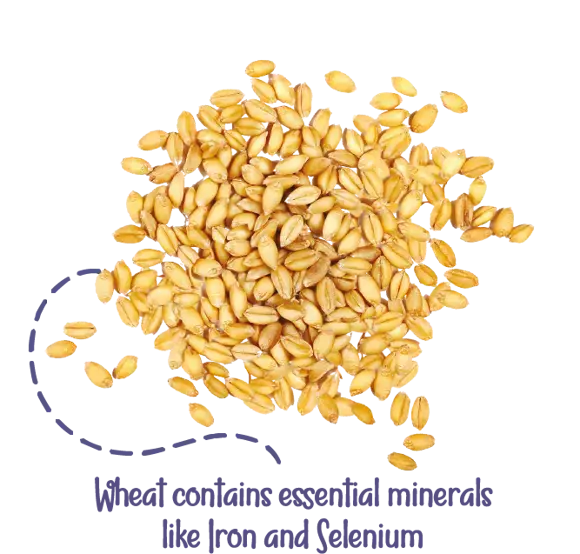Multigrain Cereal Benefits

The multigrains in Cerelac® Farmer’s Selection are exclusively farmed to ensure the highest quality standards.
In many countries, infant cereals are among the first solid food types to be introduced.1,2 Infant cereals are an excellent source of energy for babies once they reach 6 months of age and can no longer get all the nutrients they need from breast milk.3 Selecting a cereal that is comprised of multigrains, means babies receive all the benefits associated with each individual grain, from a single serving.

Quinoa is an ancient grain4 and is regarded as a superfood.4,5 It is a starchy seed that resembles other cereal grains, but has superior nutritional qualities and health benefits.4,6 It is nutrient-rich4,7,8 and supports digestive health and immunity.4,9
Quinoa contains a complex mix of macronutrients (carbohydrates, fats and proteins) and micronutrients (minerals and vitamins)10, it is considered unique because it has an optimal balance of these nutrients, in addition to all nine essential amino acids.4,11 High concentrations of amino acids and iron support the immune-boosting properties of quinoa4,12, whilst flavonoids contribute to its antioxidant activity.6 Quinoa is also gluten-free7 and can significantly improve the nutritional content of a diet lacking gluten.9

Barley is a source of vitamin B3 (Niacin) and other B vitamins.13 The vitamin B family, including niacin, contributes to promoting a healthy nervous system and improving cognitive function.14

Rice is an excellent source of folic acid, which is the synthetic form of folate (vitamin B9).18,19 Folate is involved in cellular division and DNA synthesis20,21 and deficiencies can cause megaloblastic anemia.22 An infant’s folate requirements increase once they reach 6 months of age.19 Rice is also a good source of magnesium, which is involved in nerve transmission and, thus, supporting the function of the nervous system, as well as maintaining healthy bones.23,24

Wheat is a good source of vitamins and minerals, including selenium and iron.25 The addition of whole grain wheat to infant cereals can exert a prebiotic effect on the infant’s gut microbiota.26 Selenium has many health benefits; it supports immunity and has antioxidant and anti-inflammatory properties.27 Iron is involved in brain development and adequate intake supports cognitive ability.28,29

Corn contains vitamin C, which enhances iron absorption.30,31 It is also another source of dietary fiber, supporting digestive health and lowering the risk of obesity later in life.32
References:
1. Butte NF, Fox MK, Briefel RR, et al. Nutrient Intakes of US Infants, Toddlers, and Preschoolers Meet or Exceed Dietary Reference Intakes. J Am Diet Assoc. 2010;110(12):S27-S37. doi:10.1016/j.jada.2010.09.004
2. Freeman V, Van’t Hof M, Haschke F. Patterns of milk and food intake in infants from birth to age 36 months: The Euro-Growth study. J Pediatr Gastroenterol Nutr. 2000;31(SUPPL. 1):S76-85. doi:10.1097/00005176-200007001-00008
3. Fewtrell M, Bronsky J, Campoy C, et al. Complementary feeding: A position paper by the European Society for Paediatric Gastroenterology, Hepatology, and Nutrition (ESPGHAN) committee on nutrition. J Pediatr Gastroenterol Nutr. 2017;64(1):119-132. doi:10.1097/MPG.0000000000001454
4. Angeli V, Silva PM, Massuela DC, et al. Quinoa (Chenopodium quinoa Willd.): An overview of the potentials of the “golden grain” and socio-economic and environmental aspects of its cultivation and marketization. Foods. 2020;9(2). doi:10.3390/foods9020216
5. van den Driessche JJ, Plat J, Mensink RP. Effects of superfoods on risk factors of metabolic syndrome: a systematic review of human intervention trials. Food Funct. 2018;9(4):1944-1966. doi:10.1039/C7FO01792H
6. Abugoch James LE. Quinoa (Chenopodium quinoa Willd.): Composition, chemistry, nutritional, and functional properties. Adv Food Nutr Res. 2009;58:1-31. doi:10.1016/S1043-4526(09)58001-1
7. Filho AMM, Pirozi MR, Borges JTDS, Pinheiro Sant’Ana HM, Chaves JBP, Coimbra JSDR. Quinoa: Nutritional, functional, and antinutritional aspects. Crit Rev Food Sci Nutr. 2017;57(8):1618-1630. doi:10.1080/10408398.2014.1001811
8. Graf BL, Rojas-Silva P, Rojo LE, Delatorre-Herrera J, Baldeón ME, Raskin I. Innovations in Health Value and Functional Food Development of Quinoa (Chenopodium quinoa Willd.). Compr Rev Food Sci Food Saf. 2015;14(4):431-445. doi:10.1111/1541-4337.12135
9. Lee AR, Ng DL, Dave E, Ciaccio EJ, Green PHR. The effect of substituting alternative grains in the diet on the nutritional profile of the gluten-free diet. J Hum Nutr Diet. 2009;22(4):359-363. doi:10.1111/j.1365-277X.2009.00970.x
10. Rodríguez JP, Rahman H, Thushar S, Singh RK. Healthy and Resilient Cereals and Pseudo-Cereals for Marginal Agriculture: Molecular Advances for Improving Nutrient Bioavailability. Front Genet. 2020;11. doi:10.3389/fgene.2020.00049
11. Nutritional value- International Year of Quinoa 2013.
12. Rao NK, Shahid M. Quinoa-A Promising New Crop for the Arabian Peninsula. J Agric Environ Sci. 2012;12(10):1350-1355. doi:10.5829/idosi.aejaes.2012.12.1
13. FoodData Central. Barley flour or meal. Accessed October 13, 2021. https://fdc.nal.usda.gov/fdc-app.html#/food-details/169739/nutrients
14. Kennedy DO. B vitamins and the brain: Mechanisms, dose and efficacy—A review. Nutrients. 2016;8(2). doi:10.3390/nu8020068
15. Klose C, Arendt EK. Proteins in Oats; their Synthesis and Changes during Germination: A Review. Crit Rev Food Sci Nutr. 2012;52(7):629-639. doi:10.1080/10408398.2010.504902
16. Mayo Clinic. Dietary fiber: Essential for a healthy diet. Accessed October 13, 2021. https://www.mayoclinic.org/healthy-lifestyle/nutrition-and-healthy-eati…
17. El Khoury D, Cuda C, Luhovyy BL, Anderson GH. Beta glucan: health benefits in obesity and metabolic syndrome. J Nutr Metab. 2012;2012:851362. doi:10.1155/2012/851362
18. FoodData Central. Rice, white, medium-grain, enriched, cooked. Accessed October 14, 2021. https://fdc.nal.usda.gov/fdc-app.html#/food-details/168880/nutrients
19. Folate - Health Professional Fact Sheet. Accessed October 14, 2021. https://ods.od.nih.gov/factsheets/Folate-HealthProfessional/
20. Chan Y-M, Bailey R, O’Connor DL. Folate. Adv Nutr. 2013;4(1):123. doi:10.3945/AN.112.003392
21. Liew SC. Folic acid and diseases - Supplement it or not? Rev Assoc Med Bras. 2016;62(1):90-100. doi:10.1590/1806-9282.62.01.90
22. Revuelta JL, Serrano-Amatriain C, Ledesma-Amaro R, Jiménez A. Formation of folates by microorganisms: towards the biotechnological production of this vitamin. Appl Microbiol Biotechnol. 2018;102(20):8613. doi:10.1007/S00253-018-9266-0
23. de Baaij JHF, Hoenderop JGJ, Bindels RJM. Magnesium in man: Implications for health and disease. Physiol Rev. 2015;95(1):1-46. doi:10.1152/physrev.00012.2014
24. Kirkland AE, Sarlo GL, Holton KF. The role of magnesium in neurological disorders. Nutrients. 2018;10(6). doi:10.3390/nu10060730
25. FoodData Central. Wheat flour, whole-grain, soft wheat. Accessed October 14, 2021. https://fdc.nal.usda.gov/fdc-app.html#/food-details/168944/nutrients
26. Costabile A, Klinder A, Fava F, et al. Whole-grain wheat breakfast cereal has a prebiotic effect on the human gut microbiota: A double-blind, placebo-controlled, crossover study. Br J Nutr. 2008;99(1):110-120. doi:10.1017/S0007114507793923
27. Rayman MP. Selenium and human health. Lancet. 2012;379(9822):1256-1268. doi:10.1016/S0140-6736(11)61452-9
28. Oski FA, Honig AS. The effects of therapy on the developmental scores of iron-deficient infants. J Pediatr. 1978;92(1):21-25. doi:10.1016/S0022-3476(78)80063-8
29. Lozoff B, Beard J, Connor J, Felt B, Georgieff M, Schallert T. Long-lasting neural and behavioral effects of iron deficiency in infancy. Nutr Rev. 2006;64(5 SUPPL. 1). doi:10.1301/nr.2006.may.S34-S43
30. Scientific Opinion on the substantiation of a health claim related to vitamin C and increasing non haem iron absorption pursuant to Article 14 of Regulation (EC) No 1924/2006. EFSA J. 2014;12(1). doi:10.2903/J.EFSA.2014.3514
31. Cook JD, Monsen ER. Vitamin C, the common cold, and iron absorption. Am J Clin Nutr. 1977;30(2):235-241. doi:10.1093/ajcn/30.2.235
32. Anderson JW, Baird P, Davis RH, et al. Health benefits of dietary fiber. Nutr Rev. 2009;67(4):188-205. doi:10.1111/j.1753-4887.2009.00189.x